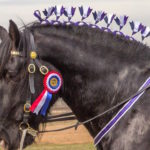Shire horses are known for being turned out to a very high standard when showing. The traditional decorations put on the Shire are designed to draw the eye and enhance the overall picture of the horse.
An adult Shire horse of any sex turned out in the traditional method will have:
- A mane roll
- Flights
- An anchor plait for a neck ribbon
- A neck ribbon
- Tail sprigs
- A tail bun
- A tail loop – also known as a jug handle
- Tail bun ribbons
Adult Shire stallions also wear a stallion roller, which will generally match the colours of the decorations used.
Younger horses are presented in the same manner, but without the mane roll and flights. The age at which the mane roll and flights are added to the horse varies between exhibitors, but all horses are expected to be presented with a mane roll and flights by age two.
Mane Roll
The mane roll used in showing Shire horses is a three strand plait added to the top of the neck. It can be made from wool, stuffed tubes or even raffia and coloured binding tape.
Here’s what they look like:
The mane roll plait is a standard three strand plait that is attached to the horse’s neck by picking up hair each time you cross from the nearside of the horse’s neck and braiding it in. Each piece of hair picked up remains in the plait until its length runs out.
A good mane roll needs to be plaited quite tight so that it stays in without moving.
Here’s a great video from Heavy Horse Decorations in the UK that shows how to put in a mane roll:
Flights
Flights are used to draw attention and accentuate the line of the horse’s neck. They are generally made with a length of florist wire on the end and are plaited into the mane roll as you go. Much the same as the hair, flights are put in at particular crossovers and then continue to be braided in until the length of wire runs out.
How many flights are put in a Shire mane roll differs between exhibitors, but it is usually an odd number. Generally speaking they’re set close together so that the corner of each flight almost touches the next. Adult horses carry approximately 9-13 flights depending on the spacing.
Here’s how they look:
There are several different styles of flights available. Here are a few examples:
Anchor Plait
This is a small plait made with hair and raffia near the wither. It is used to anchor the neck ribbon so it doesn’t slide around. There are several different ways to do an anchor plait – some exhibitors make one in the style of a tail sprig, others make a loop. Either way is fine as long as you’ve got something to tie the neck ribbon to.
Neck Ribbon
Neck ribbons are tied around the base of the horse’s neck with a bow at the top around secured around the anchor plait. They can be single, double or triple coloured depending on the decoration set purchased. Some are simply a length of ribbon so appear round at the centre of the chest, while others have a ‘v’ sewn in which helps the ribbon sit neatly.
Tail Sprigs
Tail sprigs are made from hair and raffia and are placed in the very top outside edges of the tail. They’re a four strand plait – two hair and two raffia – that is crossed over repeatedly to make a sprig that stands vertically. Some raffia is left in a fan-like shape at the top of the sprig and in most cases a tail flight or pin will be added to the sprig.
Tail Bun
The tail bun gathers up a section of hair at the top of the tail and forms a tight bun that the tail loop and ribbons are fixed to. For adult horses, most exhibitors will take a section of hair three to four inches top to bottom and divide it into three sections. Those three sections are plaited, looped up toward the top of the tail, threaded back through the base of the plait and pulled through. The remainder of the plait is wrapped around and secured tightly, forming a bun.
Here’s a great video from Heavy Horse Decorations in the UK that shows how to put in a tail bun:
Tail Loop & Ribbons
The tail loop usually has a spike and strings used to secure it to the bun. The spike is placed into the middle of the bun (making sure to avoid the base of the horse’s tail!) and the strings wrapped around the bun and tied tightly.
Once the tail loop is in, ribbons are added to the bun and tied. This ribbon is traditionally kept quite short and matches the colours used in the rest of the decoration set.
Long Tails
Traditionally, a Shire is shown with the tail hair cut quite short. This is to allow the judge to see the horse’s action from behind without a tail in the way.
Some exhibitors choose not to cut their horse’s tail hair. This is perfectly acceptable, however the tail still needs to be plaited up so that it is out of the way. When a horse with a long tail is being presented, the sprigs and tail bun at the top of the tail will be prepared in the same way. The remaining hair is then braided, folded up onto itself and secured tightly.
Here’s a great video from Heavy Horse Decorations in the UK that shows how to put in a long tail plait:
NB: The flights and mane rolls pictured on this page that are not in horses are all made by Elaine at Heavy Horse Decorations.





















